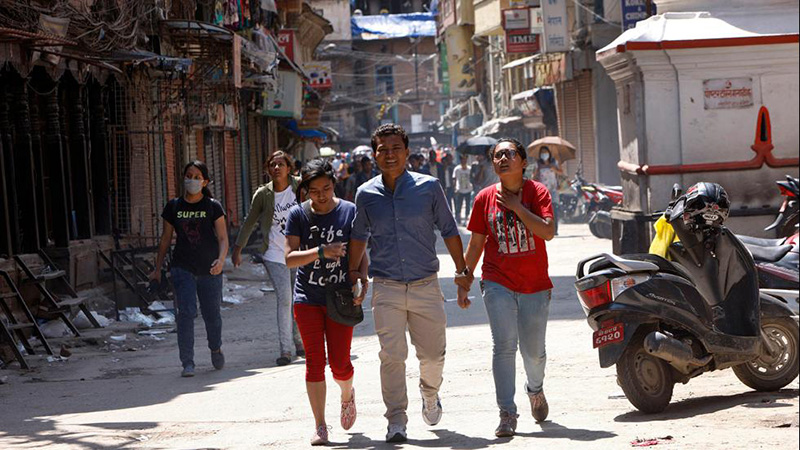
Recovery efforts in Nepal became more complicated after the country underwent another major earthquake on Tuesday, leaving dozens more dead and more than 1,000 injured. Relief organizations, including those with a Christian background, have been overcoming this latest challenge to help in the cleanup and recovery.
According to Greg Botelho and Jethro Mullen of CNN, at least 65 people died in Nepal from the latest earthquake, which had a magnitude of 7.3. The effects also spread to India and China, where 17 people and a woman in Tibet died in the respective countries.
"For the first seconds, it was complete silence. By the fifth second, everybody started to scream," 41-year-old Spanish documentarian Marc Sarrado said. "It was really, really intense. Even when the shaking stopped, people were still screaming."

The U.S. Geological Survey indicated to CNN that the magnitude-7.3 earthquake struck about 9.3 miles deep. However, this quake was different from the one that struck Nepal on April 25.
"In comparison, the magnitude-7.8 quake on April 25 -- which killed more than 8,000 people -- was centered to the northwest, rather than to the east, of Kathmandu and a little farther away (48 miles rather than 47 miles)," Botelho and Mullen wrote. "Although at a similar depth, that earlier tremor was more than three times bigger and 5.6 times stronger, in terms of energy released, according to the USGS."
According to CNN, open space has become a precious commodity in Nepal's capital, Kathmandu. Paul Dillon, a spokesman for the International Organization for Migration, saw "hundreds of people pouring out of ... buildings (amid) a lot of confusion, a lot of anxiety" as he drove around the city.
"You never get used to seeing telephone poles swaying and surfing past you," Dillon said. "Or buildings just wobbling ... as the earth moves beneath your feet."

Journalist Bhrikuti Rai told CNN that she saw many people carrying tents and mats as part of a plan to sleep outside.
"Just when people are thinking life is returning back to normal, this has once again created fear," Rai said.
According to CNN, the short length of time in between Nepal's two major earthquakes indicated that more tremors could come at any time. CNN meteorologist Chad Myers noted that the country was located in an area where the Eurasian and Indian plates collided.
"It's land crashing into land (and) it's going up, not going under," Myers said. "Every time it crashes, the Earth moves. Every time it shakes, there's strain."

USGS geophysicist Amy Vaughn told CNN that the 7.3 quake was technically an aftershock. However, she thought that it would take some time for seismic activity to settle down in Nepal.
"Generally, in the days and weeks and months (seismic activity) tapers off usually, and the intensity and frequency of the aftershocks will die down," Vaughan said. "But ... this is going to temporarily increase (the aftershocks)."
As for the relief efforts in the region by Christian organizations, Taun Cortado of Gospel for Asia reported in a press release that the organization has teams in both India and Nepal assessing the damage from the earthquake. Gospel for Asia photojournalist Raahi described the chaos caused by the tremor; he was with a team helping to deliver relief supplies to rural areas of Nepal when the earthquake struck.
"People were screaming and crying," Raahi said. "Kathmandu now looks like a ghost town, with only 25 percent of the shops remaining open. People are afraid to enter any buildings. Restaurants are mostly closed. Many have stopped coming into Kathmandu to work. They are too afraid."

Raahi added that there was a pervasive sense of fear gripping the country. The organization noted that has exhausted its supply of temporary relief tents.
"People who have already lost so much are beginning to lose hope," Raahi said. "Tomorrow we will continue on with relief work. Pray that we can get to our destination safely."
Mark W. Gaither of Global Aid Network, or GAIN, issued a press release in regards to the aftermath of the earthquake in Nepal. Phil Liller, director of the GAIN Logistics Center in Pennsylvania, elaborated on his observations back in that country.
"We spent a week there and formed friendships with the Nepal Campus Crusade for Christ team," Liller said. "This is hard for me to see a second big earthquake has happened to them."
Liller added that "90 percent of Kathmandu was okay." The earthquake damage, he noted, was mostly in the mountainous districts.
"The earthquake crossed the top of Nepal north of Kathmandu and even more east. So 50 Kilometers east of Kathmandu, there is a lot of structural damage," Liller said. "Things are just leveled. You could see the damaged area in red on the UN maps."

Given that Nepal's monsoon season is about to start soon, Liller stated that "large tarps and tents" would be needed. He met a staff member who faced that dire situation with his pregnant wife.
"Now their house did not fall down, but it was structurally damaged. They cannot go back in. They must tear it down and rebuild," Liller said. "But they cannot tear it down and rebuild in the month before the monsoon comes. Where are they going to live? Under that tarp? Think about what happens under a small tarp. The rain comes in, the ground gets wet."
Liller added that he never saw "an environment as difficult as Nepal" in terms of relief efforts.
"Of all the environments on the earth, Nepal has to be one of the worst for getting aid to people. But we won't give up," Liller said.
However, Liller concluded that GAIN's connection with Nepal Campus Crusade for Christ would greatly help relief efforts in that country.
"If they have 300 staff across Nepal, already integrated into the communities, knowing the community leaders, integrated into the churches and everything else, the distribution network is there," Liller said.














